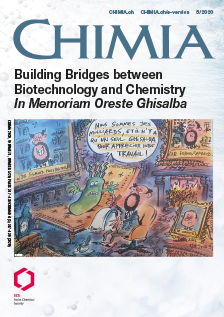Membrane Filtration: Expanding the Areas of Application by Chemical Modification – Examples from the FHNW
FH-HES Universities of Applied Sciences
DOI:
https://doi.org/10.2533/chimia.2020.423PMID:
32482224Keywords:
Lbl coating, Membrane filtration, Phosphorous recovery, Polymer brush, Stimulus responsiveAbstract
Membrane filtration applications are omnipresent in production processes of the food and beverage industry, in pharmaceutical production and the petrochemical industry but also in water purification for drinking water production and wastewater treatment. The main separation principle in membrane filtration is based on size exclusion which is dependent on the pore size of the membrane. Current developments based on chemical modification of these membranes have the goal to confer an additional chemical selectivity to membranes in order to broaden their areas of application. Here we present two examples of chemical membrane modifications pursued at the University of Applied Sciences and Arts Northwestern Switzerland (FHNW) which are based on a) polyelectrolyte multilayer (PEM or LbL) coatings and b) coating with stimulus responsive polymer brushes. Applications of such modified filtration membranes are e.g. selectively gated filtration and phosphorous P-recovery from acidic disintegrated sewage sludge.Downloads
Published
2020-05-27
Issue
Section
Columns, Conference Reports
Categories
License
Copyright (c) 2020 Kirsten Remmena, Joachim Koeserb

This work is licensed under a Creative Commons Attribution-NonCommercial 4.0 International License.
How to Cite
[1]
Chimia 2020, 74, 423, DOI: 10.2533/chimia.2020.423.







